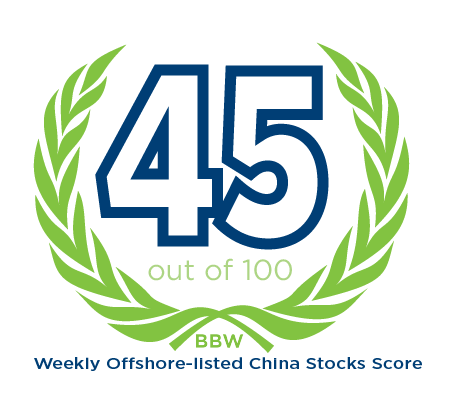CHINA BULLETIN: Revenge Spending Powers Economic Rebound


In this week’s issue GDP rebounds, China loses its population crown and TikTok’s woes take a bite out of ByteDance. On a scale of 1 to 100, we give the week a 45 for offshore-listed China stocks.
Doug Young, Editor in Chief
You can sign up to get China Bulletin weekly in your inbox.
MACRO
Revenge Spending Powers Economic Rebound
We begin this week with the latest GDP data, which shows that China’s economy expanded at a stronger-than-expected 4.5% growth rate in the first quarter. The figure marked a sharp pickup from the 2.9% growth in the fourth quarter, and was led by a spike in consumer spending as people opened their wallets for some binge buying after the end of Covid restrictions in December.
China said in March that it’s targeting “around 5%” GDP growth this year, meaning the latest figure is probably technically within that range. But even the 4.5% growth, which would have been unthinkably low just a few years ago, might be hard to maintain as consumer spending falls back to more normal levels. Continued weakness in the property and export markets won’t help either.
India Overtakes China as World’s Most Populous Country
The biggest macro story last week, and possibly for the year, was a UN forecast that India would officially overtake China this year as the world’s most populous nation. Everything is based on projections, but the UN said India’s population will hit 1.4286 billion people by the middle of this year, passing China’s 1.4257 people at that time.
This particular milestone has been coming for years, and is the result of China’s earlier one-child policy, while India imposed no restrictions. The longer-term implications are huge, since China is now heading into a “graying” era where retirees could soon outnumber working people. By comparison, India still has plenty of youth to power its economy.
Investors Worry Over GDP, Graying Population
Offshore-listed China stocks sagged a bit last week, as investors took in the relatively subdued GDP data and also the growing realization that the nation’s best economic days may be in the rear-view mirror. The Hang Seng China Enterprises Index fell 2.1% during the week, similar to a 1.7% decline for the broader Hang Seng Index. The iShares MSCI China ETF also fell 1.7%.
China’s economy appears to be in a state of major transition right now, and will need to step up development of its high-tech and services sectors to stay ahead of the latest demographic trends working against it. That means all eyes will be on big-tech and other new economy sectors to see how they’re faring when first-quarter earnings season kicks off in the next three to four weeks.

Industry
Electric Cars at Critical Juncture?
Much has been written about a broader slowdown for China’s EV sector this year, following a banner year in 2022 fueled by a flood of decent products into the market and catalyzed by government buying incentives. But a more granular analysis shows that sales continued to boom for a small group of leading players, while many smaller players are facing sharp declines.
Leaders like BYD, GAC and Li Auto all posted sales growth of more than 80% in March, while lesser-known names like Leapmotor, Xpeng and Hozon all saw their sales fall by 10% or more. This looks like the start of a classic consolidation that often comes in China, in typical boom-bust cycles fueled by strong government support, followed by rapid withdrawal of that support.
Hangzhou Speaks Up for Millions of Deliverymen
The city of Hangzhou, often seen as a leader on China’s e-commerce scene due to its status as home of Alibaba, is speaking out for the millions of scooter-bound men who deliver meals, parcels and other things to people throughout the city. Specifically, the city is calling on employers of these people to help them obtain social insurance, which is required under Chinese labor law.
This is a classic case of companies skirting China’s labor laws, which are very well meaning but often either ignored or undercut. This particular situation has drawn headlines recently after some riders, who often put in grueling days, got in accidents but couldn’t tap into China’s national health plan to pay their bills because they lacked the proper insurance.
Chinese Tourists Back on the Global Travel Map
It’s official: Chinese tourists are returning to the world’s top tourist attractions after the lifting of China’s strict Covid restrictions. But while such “revenge travel” is heating up, tourist volumes are still far below pre-Covid levels. Data from February shows Chinese visitors to Thailand were still 85% below pre-pandemic levels, while the figures were even lower for Japan and South Korea.
Of course, February isn’t exactly a high travel season, and this year it didn’t include the Lunar New Year holiday when many people travel. Additionally, China hadn’t resumed outbound package tours at that time, which are the preferred method of travel for many Chinese. And last but not least, outbound airfares remain quite high due to a limited number of international flights.

Company
BYD, Changan Set Up Overseas Shops
We begin our corporate news roundup with two stories showing how companies in China’s massive EV complex are setting up shops overseas. One item has BYD announcing plans to build a $290 million battery component plant in Chile, while the other has Changan Auto announcing plans for a $285 million EV facility in Thailand.
We’ve seen some similar announcements already, most notably by leading battery maker CATL, which is building shops in Germany and Hungary. This kind of move is designed to put makers of EVs and their components closer to their end users, and reflects China’s ambitions to become a global EV heavyweight not only at home but around the world.
Ant Gets a Break, of Sorts
Ant Financial was back in the headlines last week with an exclusive Reuters report saying the company wouldn’t get fined as much as previously expected. That may come as some relief for the company, though it will still face about $700 million in fines for regulatory violations. Beijing regulators had previously planned to fine the company $1 billion.
All these numbers are really peanuts for Ant, whose crown jewel is its Alipay that is one of two leading electronic payment services in China. The bigger significance is that finalization of the fine, along with the wind-down of a government-supervised overhaul of the company, show Ant could soon emerge from its prolonged regulatory fog and eventually relaunch its stalled IPO.
New Owner on Order for McDonald’s?
The thousands of McDonald’s restaurants in China could soon have a new owner, as Carlyle shops part of its stake in the company that owns the outlets. The U.S. private equity giant wants to sell part of its stake in the company at a valuation of $8 billion to $10 billion for the entire business, according to a Bloomberg report.
Carlyle and local financial conglomerate Citic purchased most of the McDonald’s restaurants in mainland China and Hong Kong in 2017, in a sort of corporate divorce that resembles McDonald’s business in the rest of the world where most restaurants are run by franchisees. This latest move looks like Carlyle’s way of trying to cash out on some of its investment.
AND FROM THE PAGES OF BAMBOO WORKS
| Hong Kong Steps Up Its New York Challenge Last week we spotlighted the Hong Kong Stock Exchange’s latest move to lure more Chinese tech firms, with its new plan for “specialist tech companies” launched at the end of March. The plan will allow money-losing tech companies with limited or no revenue to list in Hong Kong if they can meet other requirements for minimum market cap and revenue growth. This plan extends a series of similar steps over the last five years that Hong Kong has taken to make itself more competitive with New York, which already allows a much wider range of early-stage companies to list. The move should certainly make Hong Kong more attractive, though observers say the city will never come close to matching New York’s liquidity. |
| TikTok Travails Take Bite Out of ByteDance So, how much exactly have TikTok’s recent woes cost its parent company, ByteDance? The answer could be more than $200 billion, at least if you believe the latest valuations coming from the company. ByteDance was reportedly worth “just” $220 billion when it did its latest fundraising last month, down from a peak of $460 billion in 2021. We’re being slightly unfair here in blaming TikTok’s woes for the plunge, since other big tech names like Alibaba and Tencent have also lost a huge chunk of their value over the last two years, not to mention global giants like Facebook and Amazon. Still, ByteDance’s risk factor looks bigger than many of its peers due to threats by many western governments to ban TikTok. |





